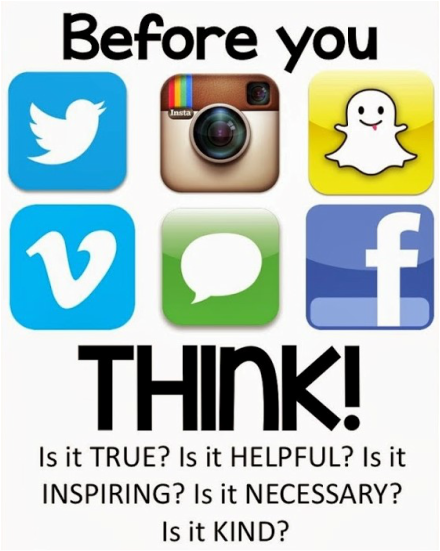Cyber threats are real. They don’t just happen to someone else, they can happen to you. The Department of Homeland Security’s National Cybersecurity Awareness Campaign — Stop.Think.Connect,™ has provided a vast resource guide to help keep ourselves and our kids safe online under all circumstances.
Now let’s talk about a big one: SOCIAL MEDIA. As parents, it’s our responsibility to teach our kids about online safety. Check out these statistics from the Pew Research Center:
DID YOU KNOW?
- 95 percent of teens use the Internet.
- 77 percent of teens use Facebook.
- 53 percent of teens use Instagram.
- 24 percent of teens use Twitter10 percent of teens use Tumblr.
- The average teen has approximately 300 friends on Facebook and 79 followers on Twitter.
- Among Twitter users aged 12 to 17, 64 percent made their tweets public.
- 19 percent of teen users have posted things they regret, including photos, videos, status updates, tweets, or comments.
- Only 18 percent of young adults claim they are comfortable with what their friends post about them online, and 32 percent say that the information about them online is what they choose for the public to see.
BE AWARE OF WHAT YOUR KIDS POST ONLINE
Understand the cyber risks kids face when using social media. Talk to your kids about the following risks:
- What they are posting: Talk to your kids about the information they post online. Many of them don’t understand the damage they could do to their reputation or future prospects with unkind or angry posts, and compromising photos or videos. Ensure your kids are not sharing or posting:
- Sensitive information: Sensitive information includes anything that can help a person steal your child’s identity or find them, such as their/your full name, Social Security number, address, birth date, phone number, or place of birth.
- Compromising content: This includes photos or status updates that may damage your child’s reputation or future prospects.
- Unkind or angry content: This includes anything malicious directed at themselves or another person, as well as opinions that are probably better left unshared.
- Who they are connecting with: Social media allows kids to connect with their friends, but there is also a risk of connecting with someone they do not know or who is only pretending to be a kid.
- What level of privacy they are using: Many social media platforms have privacy settings that allow users to limit who sees their content. There are also settings for location tracking and geo-tagging of photos or statuses.
SIMPLE TIPS FOR PARENTS
- Talk to your children. Help your children understand the importance of owning their digital lives and only sharing things that will not put them in danger, negatively affect their future, or harm others.
- Emphasize the concept of credibility to teens: not everything they see on the Internet is true and people on the Internet may not be who they appear to be.
- Watch for changes in behavior. If your child suddenly avoids the computer, it may be a sign they are being bullied or stalked online.
- Review security settings and privacy policies for the social media sites kids frequent. These settings are frequently updated so check back regularly.
ALINK Insurance Services cares about the safety of you and your family. Our children are growing up in an online world and it’s important they understand the good, the bad, and the ugly associated with that. Help us keep them safe and we’ll keep you covered along the way! Give us a call today for your home, auto, and life insurance needs.
Denver Metro/Parker: 303-752-6479
Colorado Springs: 719-473-6262
Greeley: 970-475-0900
Surrounding States: 877-643-6148
We’re your link to security!


 RSS Feed
RSS Feed
